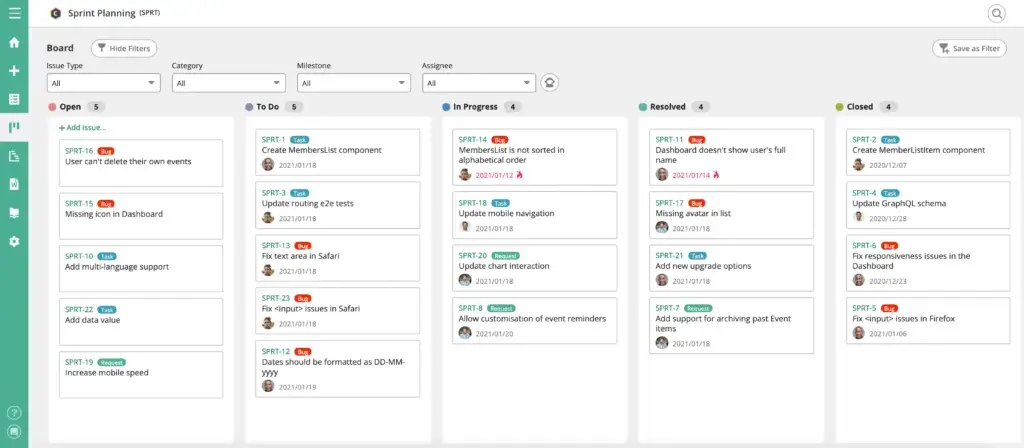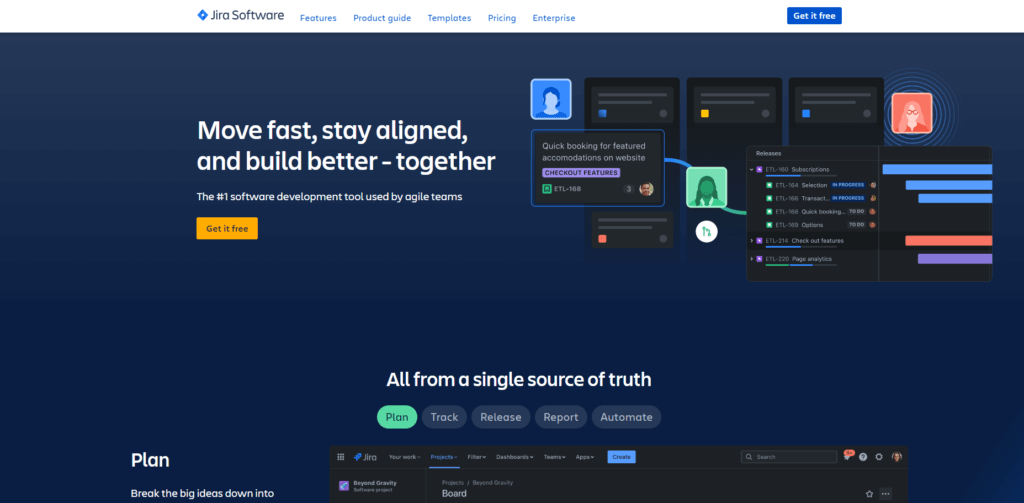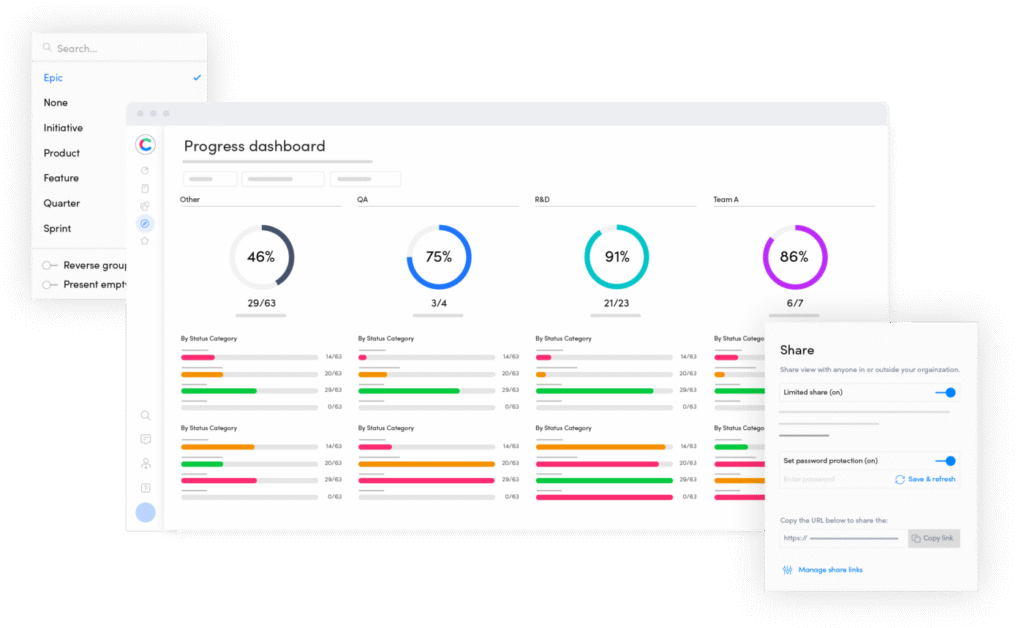
Introduction
Finding the right product management software is vital for keeping your team organised, aligned and efficient. Without a dedicated platform, roadmaps become messy, feature requests are lost in spreadsheets, and engineers and business stakeholders work in silos. This guide compares the leading solutions in 2025 so that you can choose a tool that fits your methodology, budget, and collaboration needs.
How to choose the best product management software
Choosing software for product teams isn’t just about ticking feature boxes; it’s about matching the way your team works. Before diving into individual tools, consider these criteria:
- Workflow and methodology – Make sure the platform supports the way you work, whether that’s Scrum, Kanban, mixed agile methodologies, or a bespoke process. Some tools are opinionated and work best for software teams, while others are more flexible.
- Core capabilities – Look for roadmapping, backlog management, sprint planning, issue tracking, and idea management. Not every team needs all of these, but missing a core feature will force you to rely on additional apps.
- Ease of use – A steep learning curve slows down adoption. Examine the user interface, onboarding resources, and how quickly new team members can get productive.
- Integration ecosystem – Your product management platform should connect with your existing tools. Common integrations include GitHub, GitLab, Slack, customer support apps, and design tools.
- Scalability and cost – Evaluate pricing tiers, free plans, and how costs increase as your team grows. Consider whether paying per user or in bundles fits your budget and whether there is a free tier for experimentation.
With these factors in mind, let’s explore seven leading platforms: monday dev, ClickUp, Bcklog, Aha!, craft.io, Linear, and Jira.

monday dev is built on the monday.com Work OS and is tailored to product and engineering teams. It bundles the entire product life cycle into one workspace so that you can plan roadmaps, run sprints, manage releases, and monitor issues without jumping between apps. The platform is organised around five phases: Plan, Execute, Release, Monitor, and Manage, each backed by specific features.
Key features of monday dev
- Prioritised roadmaps – Collect customer feedback and feature requests in a central backlog, rank them using built‑in frameworks, and visualise them on an interactive roadmap. Hierarchies link initiatives to epics, stories, and tasks so you always know how work connects to strategy.
- Sprint management and boards – Use Scrum or Kanban boards to plan sprints, assign tasks, and track progress. Built‑in AI provides sprint summaries that highlight velocity and unplanned work, and daily standups can be automated so that meetings stay concise.
- Release coordination – Create shareable release plans that align development, marketing and customer teams. Collaborative documents help you draft requirement specs and release notes directly in the tool.
- Bug and incident tracking – Report bugs through custom forms, categorise them by severity and integrate them with GitHub or GitLab. Incident boards and real‑time alerts help teams respond quickly to production issues.
- Cross‑team collaboration – Because monday dev is part of the larger monday.com ecosystem, non‑technical departments can watch progress without learning a new system. Unlimited viewer seats mean executives and stakeholders can follow along without extra licences.
Pros and cons
Positive
✅ High level of customization
✅ Integrated developer tooling
✅ AI‑powered efficiency
✅ Real‑time reporting and dashboards
Negative
❌ Learning curve
❌ Requires some technical knowledge
❌ Limited offline capabilities
❌ Performance with large datasets
Pricing
monday dev offers four paid tiers with a free trial. Basic starts around $9 per seat per month and provides unlimited items, development templates and dashboards on a single board. Standard, at about $14 per seat per month, adds timeline and Gantt views, guest access, a single product roadmap, and GitHub integration. Pro, roughly $23 per seat per month, introduces private boards, time tracking, advanced reporting, and cross‑team roadmaps. Enterprise pricing is custom and includes advanced security, multi‑level permissions, extensive automation, and dedicated onboarding. Note that seats are sold in bundles, so costs can jump when your team grows beyond a bundle threshold.
Best for
monday dev suits cross‑functional product and engineering teams that want an intuitive, visual workspace for planning roadmaps, running sprints, and centralising customer feedback. It’s especially attractive if you value AI‑assisted standups and real‑time dashboards and are willing to invest in a premium platform.

Backlog by Nulab is a project management platform designed to bring developers, designers, and non-technical teams together in one workspace. It merges task tracking, version control, and team collaboration, making it ideal for managing software projects, bug tracking, and documentation. With built-in Git and SVN repositories, Backlog offers a unique blend of project visibility and developer-friendly tools.
Key features of Backlog
- Comprehensive issue tracking – Create, assign, and prioritize issues with custom categories, due dates, and statuses. Teams can easily monitor bug reports, feature requests, and release progress through Kanban boards or Gantt charts.
- Built-in Git and SVN repositories – Manage source code directly within Backlog without relying on external tools. Developers can commit changes, review diffs, and track code updates in real time alongside project tasks.
- Wikis and documentation – Collaborate on technical documentation, meeting notes, and knowledge bases using Backlog’s built-in wiki system. Everything stays organized and linked to relevant tasks or milestones.
- Milestones and version management – Plan product releases, track sprints, and visualize dependencies using milestones and version control features. The Gantt chart view helps align releases and deadlines across teams.
- Team collaboration tools – Comment on issues, mention teammates, share files, and manage discussions all within one interface. Notifications and activity feeds ensure everyone stays updated on project changes.
- Integrations and automation – Connect with tools like Slack, Typetalk, Cacoo, Jenkins, Zapier, and more. Backlog’s API enables custom workflows and automated updates across your tool stack.
Pros and cons
Positive
✅ User‑friendly interface
✅ Robust collaboration
✅ Integrated version control
✅ Comprehensive issue tracking
Negative
❌ Performance on very large projects
❌ Mobile app limitations
❌ Limited reporting customization
❌ Smaller integration ecosystem
Pricing
Backlog offers a Free Plan for up to 10 users with 1 project and 100 MB storage, ideal for small teams or testing. The Starter plan (around $35/month flat) supports up to 30 users, 5 projects, and 1 GB storage. The Standard plan (about $100/month) includes unlimited users, 30 projects, and 5 GB storage. The Premium plan (roughly $175/month) provides unlimited projects, 10 GB storage, and advanced administrative options. Enterprise plans are available for on-premise hosting and tailored support.
Best for
Backlog is best suited for software development teams and cross-functional product groups that need both project management and code management in a single platform. Its simplicity appeals to startups and small businesses, while the integration of Git/SVN makes it ideal for engineering teams seeking transparency across product design, development, and delivery.

ClickUp positions itself as the “one app to replace them all.” It combines task management, document collaboration, time tracking, and automation into a single platform. Whether you’re managing individual tasks, planning releases, or drafting product documentation, ClickUp aims to keep everything under one roof.
Key features of ClickUp
- Flexible task management – Create tasks with custom statuses, priorities and dependencies. Switch between List, Board, Calendar, Gantt, and Mind Map views to see your work from multiple angles.
- Custom workflows and automation – Build workflows tailored to your processes using custom task statuses and automation rules. Trigger notifications, assign tasks and update fields automatically to remove repetitive work.
- Scheduling and time tracking – Estimate time, track actual time and visualise workload in workload views. ClickUp integrates with popular trackers like Toggl and Harvest for advanced time reporting.
- Dashboards and reporting – Custom dashboards give you an overview of progress, team performance and key metrics. You can create simple widgets for daily tasks or detailed analytics for sprint retrospectives.
- Docs, whiteboards and collaboration – Beyond task lists, ClickUp offers a document editor and whiteboard tool. You can build wikis, meeting notes and brainstorming boards, all of which support real‑time co‑authoring.
- Extensive integrations – Connect with Slack, Google Drive, Zoom, GitHub, Zapier and hundreds of other apps. API access allows you to build custom integrations and automations.
Pros and cons
Positive
✅ Highly customisable workflows
✅ Generous free plan with unlimited tasks
✅ Multiple project views
✅ Powerful automation
Negative
❌ Steep learning curve due to the feature set
❌ Potentially overwhelming for small teams
❌ Mobile app lacks some advanced options
Pricing
ClickUp provides a Free Forever plan with unlimited tasks and members but limited storage. The Unlimited plan at about $7 per user per month (annual billing) adds unlimited storage and integrations. Business at around $12 per user per month offers advanced time tracking, Google SSO, and enhanced reporting. Business Plus, roughly $19 per user per month, includes custom role permissions and priority support. Enterprise plans are custom-priced and unlock advanced security features and dedicated support.
Best for
ClickUp appeals to teams that want a single workspace to manage tasks, documents and timelines. Its rich free plan suits freelancers and small teams, while larger organisations benefit from deep automation, reporting, and security features. If flexibility and customisation are your priorities and you’re prepared to invest time in learning the platform, ClickUp stands out.

Aha! is a suite of product management modules designed for organisations that need to align strategy with execution. Originally launched as a roadmapping tool, it has grown to include idea crowdsourcing, collaborative notebooks and an agile development module. Instead of trying to replace every other app, Aha! focuses on strategic planning and customer feedback.
Key features of Aha!
- Roadmapping and strategy management – Create visual roadmaps that link high‑level objectives to epics, features and releases. Prioritisation scoring helps you decide which initiatives deliver the most value relative to effort. Shared roadmaps keep stakeholders aligned without constant slide decks.
- Idea management – Capture feedback through custom portals or embedded forms. Contributors can vote on suggestions, and product managers can score ideas based on business impact. Once validated, ideas flow straight into your backlog and roadmap.
- Knowledge and collaboration – The Notebooks module serves as a digital workspace for notes, wikis and whiteboards. Teams can co‑author documents in real time and attach roadmaps and reports directly to their notes.
- Aha! Develop integration – For teams that want development and product management in one suite, Aha! Develop offers agile boards, sprint planning and DevOps integrations. Issues move directly from the backlog into the developer workflow.
Pros and cons
Positive
✅ Centralized product management
✅ Powerful roadmapping
✅ Idea crowdsourcing and scoring
✅ Strong collaboration features
Negative
❌ Steep learning curve
❌ Complex user interface
❌ High pricing for full suite
❌ Limited visual customization
Pricing
Aha! sells each product separately. Roadmaps starts at about $59 per user per month for the Essentials plan and ranges up to roughly $99–$149 per user per month for Advanced or Enterprise tiers. Ideas begins around $39 per user per month (minimum three users) and climbs to about $59. Notebooks costs roughly $9 per user per month for Essentials and about $18 for Advanced. Develop is similarly priced at roughly $9 or $18 per user per month, depending on features. Each module includes a 30‑day free trial, but combining them quickly increases costs.
Best for
Aha! is suited to mid‑sized and large organisations that need robust strategic planning and idea management. If your team manages complex product portfolios and requires a centralised feedback system, Aha! provides structure and depth. Smaller teams may find the pricing and learning curve burdensome.

Linear is a modern issue tracker and project management tool designed for speed. Instead of trying to be an all‑purpose hub, Linear focuses on delivering a lightning‑fast, keyboard‑friendly interface for software development teams. Its opinionated workflows encourage consistent practices and reduce configuration overhead.
Key features of Linear
- Issue tracking and triage – Capture bugs, feature requests and tasks in a structured way. A dedicated Triage inbox keeps incoming issues separate from your main backlog so you can review and categorise work before it becomes noise.
- Cycles and roadmaps – Replace manual sprint rollover with time‑boxed cycles that automatically carry unfinished work into the next cycle. Group related issues into projects and roadmaps to track progress against milestones and communicate release plans to stakeholders.
- Workflow and integrations – Seamlessly connect with GitHub and GitLab so that merging a pull request updates issue status. Integrations with Slack, Microsoft Teams, Figma, Sentry and webhooks keep your workflow cohesive. Keyboard shortcuts are available for nearly every action, reducing friction for developers.
- Search, filtering and analytics – Powerful semantic search and filters help you find issues quickly. Built‑in analytics show cycle completion rates and throughput; while not as deep as enterprise tools, they provide enough insight to identify bottlenecks.
Pros and cons
Positive
✅ Exceptional speed
✅ Intuitive interface
✅ Developer‑centric features
✅ Quick onboarding
Negative
❌ Limited customization
❌ Narrow focusal knowledge
❌ Premium pricing
❌ Basic reporting
Pricing
Linear offers a Free plan that supports up to 250 active issues and unlimited archived issues; it includes all integrations and API access. The Basic plan, starting around $8 per user per month, removes the issue cap and adds admin roles and unlimited file uploads. The Business plan, roughly $14 per user per month, introduces private teams, guest accounts, and advanced analytics. The Enterprise plan has custom pricing and provides single sign‑on, SCIM provisioning, higher API limits, and dedicated migration assistance.
Best for
Linear is best suited to software development teams that value speed, minimalism, and keyboard‑driven workflows. If your developers spend more time in code editors than in project management tools, Linear can dramatically reduce context switching. Non‑technical departments may find it too specialised, and organisations needing extensive reports or complex workflows should look elsewhere.

Jira Software by Atlassian is the industry standard for agile development teams. Originally built for bug tracking, it has evolved into a comprehensive platform for Scrum, Kanban and DevOps workflows. With thousands of integrations and granular customisation, Jira scales from small start‑ups to large enterprises but demands time to configure and learn.
Key features of Jira
- Agile project management – Create Scrum or Kanban boards to visualise workflows, manage backlogs and plan sprints. Customisable boards allow you to define statuses and transitions that match your process.
- Workflow customisation – Design bespoke workflows with specific issue types, transitions and conditions. Map statuses to steps like “Open,” “In Progress,” “Code Review” and “Done” so that tasks progress logically.
- Advanced reporting and analytics – Gain real‑time insight through burndown charts, velocity reports and cumulative flow diagrams. These analytics help you identify bottlenecks, estimate capacity and improve processes.
- Extensive integration ecosystem – Connect Jira to over 3 000 applications, including Bitbucket, GitHub, Jenkins, CircleCI, Slack and Confluence. These integrations create an end‑to‑end development pipeline from code commit to deployment.
- Security and permissions – Configure granular permissions at the global, project and issue levels. Support for two‑factor authentication and single sign‑on helps enforce compliance with industry standards.
- Roadmaps and mobile access – Build high‑level roadmaps, track dependencies and adjust plans as priorities change. Mobile apps for iOS and Android allow team members to view tasks and receive notifications on the go.
Pros and cons
Positive
✅ Comprehensive Agile Support
✅ Extensive Integration Ecosystem
✅ Advanced Reporting and Analytics
✅ Scalability for Large Teams
Negative
❌ Steep Learning Curve
❌ Performance Issues with Large Projects
❌ Complexity in Setup and Maintenance
❌ User Interface Concerns
Pricing
Jira offers a Free plan for up to 10 users with 2 GB of storage and community support. The Standard plan costs about $7.75 per user per month and increases storage to 250 GB while adding advanced permissions and roles. The Premium plan, around $15.25 per user per month, provides unlimited storage, premium support and uptime SLAs. The Enterprise tier has custom pricing, unlimited users and enhanced security and compliance features.
Best for
Jira is ideal for agile software development and IT teams that need extensive customisation, deep integration with developer tools and comprehensive reporting. Large enterprises will appreciate its scalability and granular permissions. Non‑technical or small teams may find the interface overwhelming and should consider more user‑friendly alternatives.

craft.io offers a unified workspace for product teams that want to link strategy to execution. Its emphasis on roadmaps, prioritisation frameworks and backlog management makes it a strong choice for teams that value structured decision‑making. The software includes modules for planning, sprint management and capacity planning, with integrations to development tools.
Key features of craft.io
- Strategic roadmap planning – Build roadmaps that visualise high‑level initiatives and align them with company objectives. Switch between timeline, table, and Kanban views, and connect each initiative directly to backlog items and objectives and key results (OKRs).
- Backlog management and prioritisation – Import tasks into a structured backlog and group them into themes. Apply frameworks like RICE, MoSCoW or WSJF and plot items on a value‑versus‑effort matrix to make informed trade‑offs.
- Workflow customisation and collaboration – Design workflows with custom statuses, fields and unlimited views. Collaborate through comments, mentions, and file attachments while maintaining a single source of truth.
- User story mapping and sprint planning – Visualise user journeys by mapping epics and stories along a timeline. Plan sprints using Scrum or Kanban boards, set goals and track progress with burn‑down charts.
- Resource allocation and capacity planning – Assess team capacity, assign tasks accordingly, and avoid overcommitting. Enterprise customers can manage capacity across multiple product lines and portfolios.
Pros and cons
Positive
✅ Intuitive interface
✅ Robust integrations
✅ Advanced features
✅ Strategic focus
Negative
❌ Steep learning curve
❌ Limited out‑of‑the‑box templates
❌ English‑only support
❌ High cost for advanced features
Pricing
craft.io uses a tiered model. The Starter plan costs about $24 per user per month ($19 when billed annually) and includes one workspace with basic roadmap and backlog features. The Pro plan, at roughly $99 per user per month ($79 when billed annually), unlocks unlimited workspaces, custom fields, advanced prioritisation frameworks and design‑tool integrations; add‑ons for OKRs, feedback portals, and capacity planning cost extra. The Enterprise tier is custom-priced and includes on‑premise integrations, portfolio roadmaps, multi‑level OKRs and enterprise‑grade security with single sign‑on (SSO) and audit logs.
Best for
craft.io is ideal for mid‑sized and enterprise product teams that need sophisticated roadmaps and prioritisation. Teams that already use Jira or Azure DevOps will appreciate the two‑way sync. Smaller teams may find the cost high, but the strategic focus makes craft.io valuable for companies managing complex portfolios.
Pricing and best‑for comparison
To help you quickly compare pricing and ideal use cases, here’s a concise table summarising the six platforms reviewed above.
| Tool | Approx. price range per user/month* | Best for |
| monday dev | $9–$23+ (bundle pricing) | Cross-functional teams needing an intuitive, AI-enabled agile hub |
| ClickUp | Free–$19+ (per user) | Teams seeking a customisable all-in-one workspace with a generous free tier |
| Backlog (by Nulab) | Free–$35+ (flat or per team) | Developer and product teams needing integrated issue tracking and version control |
| Aha! | $9–$149+ (per module) | Mid-sized to enterprise teams requiring strategic roadmaps and idea management |
| craft.io | $19–$99+ (per user) | Product teams focused on advanced prioritisation and backlog management |
| Linear | Free–$14+ (per user) | Developer teams prioritising speed, minimalism and keyboard-first workflows |
| Jira | $0–$15.25+ (per user) | Agile development teams needing deep customisation and extensive integrations |
Conclusion
Product management software is not one‑size‑fits‑all. The best choice depends on your team’s size, workflow, budget and need for strategic planning versus speed. Here are the key takeaways:
-
monday dev combines roadmapping, sprint management, release planning and bug tracking into a single workspace with AI‑powered standups. It’s ideal for cross‑functional teams willing to invest in a premium, visual platform.
-
ClickUp offers a highly configurable environment that replaces multiple tools. Its generous free plan and extensive views make it appealing for small teams and startups, while larger organisations appreciate its automation and security.
- Backlog (by Nulab) bridges the gap between developers and non-technical collaborators, offering built-in Git/SVN repositories, issue tracking, and wikis in a single, cohesive system.
-
Aha! shines in strategic planning and idea management. If your focus is on aligning stakeholders around long‑term goals and capturing customer feedback, Aha! provides the structure you need, though it comes at a higher cost.
-
craft.io stands out for its prioritisation frameworks and story mapping. It’s best for teams that want to quantify value versus effort and connect strategy directly to execution.
-
Linear delivers speed and simplicity for developers who want to spend less time managing issues and more time shipping code. Its keyboard‑centric design and triage workflows streamline daily work, but it’s less suited to non‑technical teams.
-
Jira remains the industry standard for complex agile projects. Its depth of features and integrations make it indispensable for many development organisations, but you’ll need to invest time in configuration and training.
Ultimately, the best product management software is the one that aligns with your team’s processes and scales with your growth. Take advantage of free trials and free tiers to test each platform before committing.
Frequently Asked Questions (FAQs)
1. What is product management software?
Product management software helps teams plan, build, and ship products by centralising roadmaps, backlogs, feedback, and collaboration. It often includes features for prioritising features, managing sprints, tracking issues, and reporting progress.
2. How is product management different from project management?
Project management focuses on executing a specific project within defined scope, timelines and resources. Product management is broader; it involves defining product strategy, gathering user feedback, prioritising features, and guiding development throughout the product life cycle. Product management tools often include project management features but add strategic roadmapping and idea management.
3. Which features should I prioritise when selecting a product management tool?
Focus on capabilities that align with your workflow: roadmapping, backlog and feature prioritisation, sprint or cycle management, feedback collection, integration with development and design tools, reporting, and security. Ease of use and cost should also influence your decision.
4. Which product management software is best for agile development?
monday dev and Jira provide comprehensive support for Scrum and Kanban teams. monday dev offers an intuitive interface and AI‑powered summaries, while Jira delivers deep customisation and integrations. Linear also appeals to agile development teams that prioritise speed and simplicity.
5. Are there free product management tools available?
Yes. ClickUp offers a free plan with unlimited tasks and members, albeit with limited storage. Linear provides a free tier capped at 250 active issues. Jira’s free plan supports up to 10 users. These free plans are great for small teams evaluating features before upgrading.
6. How do product roadmaps help in product management?
Roadmaps visualise your product’s direction over time. They link high‑level goals to specific features and releases, helping stakeholders understand priorities and timing. A clear roadmap improves alignment, communicates trade‑offs, and prevents scope creep.
7. Do these tools integrate with GitHub, GitLab, and other developer platforms?
Yes. monday dev, ClickUp, Aha!, craft.io, Linear, and Jira all offer integrations with developer tools like GitHub or GitLab. These integrations allow you to link pull requests and commits to tasks, automate status updates, and streamline code reviews.
8. How secure are product management platforms?
The tools reviewed here offer robust security features, including encryption, role‑based access, and compliance certifications such as SOC 2 and GDPR. Enterprise plans often include single sign‑on, two‑factor authentication, and audit logs. Always review a platform’s security documentation to ensure it meets your organisation’s requirements.
9. Can these tools scale as my company grows?
Yes. monday dev, ClickUp, Aha!, craft.io, Linear, and Jira all provide plans that scale from small teams to large enterprises. Look for features like unlimited viewers, advanced permissions, custom fields, and automation to ensure the tool grows with you.
10. How do I decide between monday dev, ClickUp, Aha!, craft.io, Linear, and Jira?
Start by identifying your team’s priorities. If you need an intuitive, all‑in‑one agile hub with AI features, monday dev excels. For maximum customisation and a strong free plan, consider ClickUp. If strategic roadmapping and idea management are essential, Aha! is the leader. Teams seeking advanced prioritisation and strategic focus should look at craft.io. Developer‑centric teams that value speed will appreciate Linear. For large, technical teams requiring deep customisation and integrations, Jira remains the standard. Trying out each tool with a free trial is the best way to see which one feels right.










